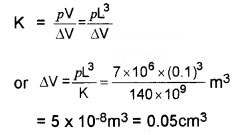Kerala Plus One Physics Chapter Wise Questions and Answers Chapter 9 Mechanical Properties of Solids
Plus One Physics Mechanical Properties of Solids One Mark Questions and Answers
Question 1.
If longitudinal strain fora wire is 0.03 and its Poisson’s ratio is 0.5, then its lateral strain is
(a) 0.003
(b) 0.0075
(c) 0.015
(d) 0.4
Answer:
(c) 0.015
Poisson’s ratio σ = \(\frac { Lateral\quad strain }{ Longitudina\quad strain } \)
Lateral strain = Longitudinal strain × σ
= 0.03 × 0.5 = 0.015.
Question 2.
Between steel and diamond, which is more elastic?
Answer:
Steel.
Question 3.
What is the value of Y for a perfectly elastic body?
Answer:
Infinity.
Question 4.
Young’s modulus of the wire depends on
(a) length of the wire
(b) diameter of the wire
(c) material of the wire
(d) mass hanging from the wire
Answer:
(c) material of the wire
Young’s modulus of wire depends only on the nature of the material of the wire.
Question 5.
Two solid spheres of the same material have the same radius but one is hollow while the other is solid. Both spheres are heated to same temperature. Then
(a) the solid sphere expands more
(b) the hollow sphere expands more
(c) expansion is same for both
(d) nothing can be solid about their relative expansion if their masses are not given
Answer:
(c) expansion is same for both.
Question 6.
For most materials the Young’s modulus is n times the rigidity modulus, where n is
(a) 2
(b) 3
(c) 4
(d) 5
Answer:
(b) 3
For most materials, the modulus of rigidity, η is one third of the Young’s modulus, Y.
η = \(\frac{1}{3}\)Y or Y = 3η
∴ n = 3.
Question 7.
The stress required to double the length of a wire of Young’s modulus Y is
(a) Y/2
(b) 2Y
(c) Y
(d) 4Y
Answer:
(c) Let L be the length of a wire.
If the length of a wire is doubled, the longitudinal strain will be
![]()
Young’s modulus Y = \(\frac{\text { Stress }}{\text { Strain }}\)
∴ Y = Stress (∵ Strain = 1).
Question 8.
What is the bulk modulus of a perfectly rigid body?
Answer:
Infinity
Question 9.
What is shear modulus of liquid?
Answer:
Zero
Question 10.
What is rigidity modulus of liquid?
Answer:
Zero.
Question 11.
Identify the type of modulus in the twisting of the cylinder.
Answer:
Shear modulus
Question 12.
Why work is required to be done to stretch a wire?
Answer:
Work is required to be done against the intermolecular forces of attraction.
Question 13.
Name the material which is famous for a large elastic after effect.
Answer:
Glass
Plus One Physics Mechanical Properties of Solids Two Mark Questions and Answers
Question 1.
Find stress required to double the length of a wire of Young’s modulus Y
Answer:
Let L be the length of a wire.
If the length of a wire is doubled, the longitudinal strain will be

Young’s modulus Y = \(\frac{\text { Stress }}{\text { Strain }}\)
∴ Y = Stress (∵ Strain = 1).
Question 2.
When wire is bent back and forth, it becomes hot. Why?
Answer:
When wire is bent back and forth, the deformations are beyond elastic limit. A part of work done is converted in to heat energy. Hence wire becomes hot.
Plus One Physics Mechanical Properties of Solids Three Mark Questions and Answers
Question 1.
The stress-strain graph of two bodies A and B are given in the figure

- Which of the material has greater youngs modulus?
- Which of the two material is preferable to be used as a rope in a crane?
- Redraw the graph and mark the regions in the graphs where the elastic force is strictly conservative
Answer:
1. Youngs modulus, Y = \(\frac{\text { Stress }}{\text { Strain }}\)
The slope of above graph gives youngs modulus. The body A has larger slope. Hence youngs modulus of ‘A ‘is greater than ‘B’.
2. The fracture point is greater for A. Hence A is stronger. Due to high strength, the material A is used as rope in a crane.
3.
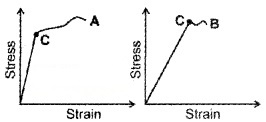
Up to point C, the elastic force is strictly conservative.
Question 2.
Hook’s law is said to be that fundamental law in elasticity.
- State Hook’s law of Elasticity.
- Name the different types of modulus of elasticity with their equations.
Answer:
1. For small deformations, the stress and strain are proportional to each other, ie: stress ∝ strain stress = k × strain. Where k is the proportionality constant and is known as modulus of elasticity.
2.

Plus One Physics Mechanical Properties of Solids Four Mark Questions and Answers
Question 1.
When an external force deforms a solid, internal restoring forces are developed in the body giving rise to stress and strain.
- Define stress and strain.
- Draw the stress-strain diagram and mark the positions of elastic limit and the regions of elastic and plastic behaviors.
Answer:
1. Stress: It is the restoring force developed per unit area of cross-section.
Strain: The ratio of change in dimension to the original dimension is called strain.
2.
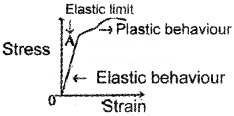
Plus One Physics Mechanical Properties of Solids Five Mark Questions and Answers
Question 1.
- Distinguish between perfectly plastic and perfectly elastic materials.
- What is the quantity obtained from the slope of a stress-strain graph and what is the area under the curve?
- Two wires have their lengths in the ratio 1:3 and radii in the ratio 2:1. What will be the ratio of elongations for the same linear stress?
Answer:
1. When deforming forces are applied on a body its volume or shape will change. On removing the deforming forces it regains its original size and shape. It is called elastic body.
On removing the deforming forces. The body which cannot retain the original shape and size is called plastic body.
2. Modulus of elasticity. Area under stress strain graph gives workdone.
3. we know l1: l2, 1 : 3
r2 : r1, 2 : 1
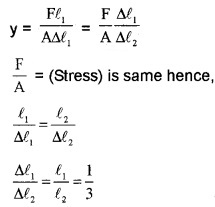
Question 2.
The modulus of elasticity of rubber is higher than that of steel.
- Do you agree with this statement? Why?
- Give your explanation.
- Prove that the elastic potential energy density of a stretched wire is half the product of stress and strain.
Answer:
1. No
2. Y = \(\frac{F l}{A \Delta l}\)
∆l is higher for rubber than steel. Hence youngs modulus is smaller for rubber than steel.
3. Workdone in stretching a wire.
= \(\frac{1}{2}\) × stretching force × extension
= \(\frac{1}{2}\) Fe
Let ‘a’ be the area of cross section and ‘L’ the length of the wire. The volume ‘aL’
Workdone for a volume ‘aL’ = \(\frac{1}{2}\)
Workdone per unit volume

Question 3.
We have common experience that a thin thread breakes if pulled at its ends. Also a thin metallic wire, when pulled at the ends elongates and then contracts, when released.
- What do you mean by elasticity?
- Draw a the stress-strain graph of a metal and mark elastic limit, plastic region, and fracture point.
- A lift is tied with thick iron wires and its mass is 1000kg. What should be the minimum diameter of the wire if the maximum acceleration of the lift is 1.2 m/s2 and maximum safe stress of the wire is 1.4 × 108 N/m2 (g = 9.8m/s2)
Answer:
1. Elasticity of a body is the property of the body by virtue of which the body gains its original shape and size when the deforming force is removed.
2. Stress strain curve
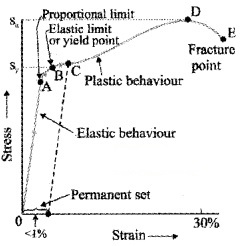
3. When the lift goes upward with as acceleration a, then tension in the wires,
T = m (g + a)
= 1000(9.8 + 1.2)
= 11000N
Let r be the minimum radius of the wire
Then maximum stress = \(\frac{T}{\pi r^{2}}\)
But the maximum stress the wire can withstand = 1.4 × 108

r = 0.005m
∴ diameter = 0.01m.
Question 4.
The property of material bodies to regain its original size on the removal of deforming force is called elasticity.
- What are the values of
- Young’s modulus for a perfectly rigid body
- Rigidity modulus of a liquid
- Why do we prefer steel to copper in the manufacture of spring?
- How much should the pressure on a littre of water be changed to compress it by 0.10%?
(B = 2.2 × 109N/m2)
Answer:
1. The values:
- infinity
- Zero
2. Young’s modulus of steel is more than that of copper. Hence steel is more elastic than copper.
3.
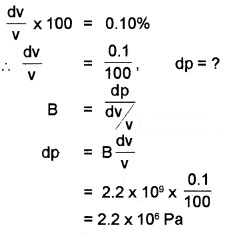
Plus One Physics Mechanical Properties of Solids NCERT Questions and Answers
Question 1.
A steel wire of length 4.7m and cross-sectional area 3 × 10-5m2 stretches by the same amount as a copper wire of length 3.5m and cross-sectional area of 4 × 10-5m2 under a given load. What is the ratio of Young’s modulus of steel to that of copper?
Answer:
For steel
l1 = 4.7m, a1 = 3 × 10-5m2
If F newton is the stretching force and ∆l metre the extension in each case, then
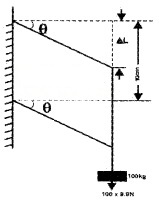
![]()
For copper
l2 = 3.5m, a2 = 4 × 10-5m2
![]()
Dividing (1) by (2), we get

Question 2.
Following figure shows the strain-stress curve for a given material. What are
- Young’s modulus and
- approximate yield strength for this material?
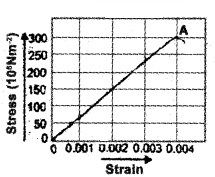
Answer:
1. It is clear from the graph that for the stress of 150 × 106Nm-2, the strain is 0.002
∴ Young’s modulus of the material
![]()
= 7.5 × 1010Nm-2.
2. It is clear from the graph that A corresponds to the yield point. So, the approximate yield strength of the material is 300 × 106Nm-2 or 3 × 108Nm-2.
Question 3.
The edge of an aluminium cube is 10cm long. One face of the cube is firmly fixed to a vertical wal. A mass of 100kg is then attached to the opposite face of the cube. The shear modulus of aluminium is 25GPa. What is the vertical deflection of this face?
Answer:
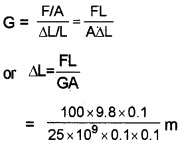
3.92 × 10-7m
≃ 4 × 10-7m.
Question 4.
A steel cable with a radius 1.5cm supports a chair lift. If the maximum stress is not to exceed 108Nm-2, what is the maximum load the cable can support?
Answer:
Maximum load = Maximum Stress × Cross sectional area
= 108Nm-2 × \(\frac{22}{7}\) × (1.5 × 10-2)-2N
= 7.07 × 104N.
Question 5.
Compute the fractional change in volume of a glass slab when subjected to a hydraulic pressure of 10atm.
Answer:
Given : Bulk modulus of elasticity of glass
= 37 × 109Nm2 and 1 atm
= 1.013 × 105Pa
p = 10 atm = 10 × 1.013 × 105Pa
Fractional change in volume = Volumetric strain
![]()
Question 6.
Determine the volume of contraction of a solid copper tube 10cm on an edge, when subjected to a hydraulic pressure of 7 × 106Pa. Bulk modulus of copper =140 × 109Pa.
Answer:
V = L3 = (10cm)3 = (0.1m)3
p = 7 × 106Pa, K = 140 × 109Pa
